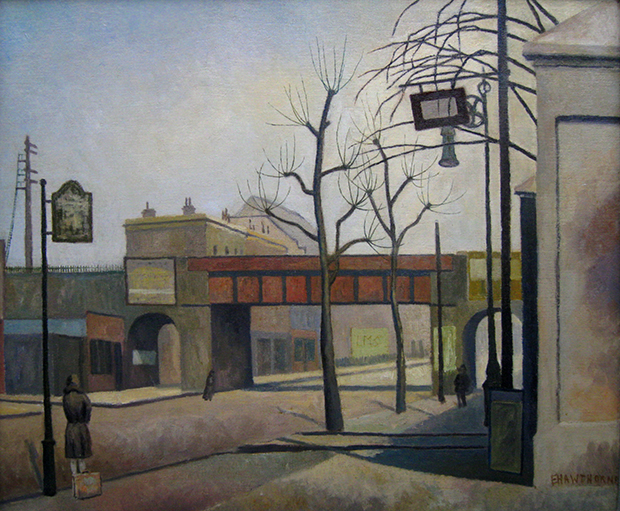East London Group reunited for Bow Arts exhibition
The East London Group was an innovative, popular and commercially successful collective of artists during the 1920s and 30s.
But fame, in the words of Emily Dickinson, is a fickle food, and so posterity chose to forget this mixture of working class ‘hobby painters’ and Slade School graduates.
But a book published last year by author David Buckman, From Bow to Biennale: Artists of the East London Group, has rekindled interest in the group, leading to an exhibition opening this month at The Nunnery gallery.
The East London on display is grey and eery. Empty bus shelters, wrought iron bridges and industrial landscapes show the effects of human activity, though people are largely absent or appear as solitary figures in great coats and hats.
“I think the pallette of colours they use is quite drab – you know, london wasn’t a particularly cheerful place then,” says Rosamund Murdoch of Bow Arts Trust.
“The sky was often hazy through pollution and I think if you’re putting it alongside the French Impressionists who were making very different work at the time it does say quite a lot about living in an overpopulated and poor East London.”
Walter Sickert was one of the group’s mentors and guest lecturers (the exhibition includes his work), and the group’s champion and founder, John Cooper, managed to attract support and finance from, among others, Samuel Courtauld as well as the writer Arnold Bennett.
The group consisted of working people such as Albert Turpin, a professional window cleaner who became mayor of Bethnal Green, and Munroe Fitzgerald, an Irish Civil War death sentence escapee. Yet under the tutorlage of Cooper’s ex-Slade friends their work went on to be displayed at the Whitechapel and Tate galleries. The critic F.G.Stone wrote that the group had found “beauty about the streets of the district that is known to the Post Office as E3”. In 1936 two of the group’s members, Elwin Hawthorne and Walter Steggles, even took part in the Venice Biennale.
“Benevolent art students coming to Bow and teaching a bunch of working class guys in the evenings comes from the idea that, in East London particularly, rich people would spend their free time and money on improving the lot of the poor,” says Murdoch.
So what happened to the East London Group and why did it drift into obscurity? It seems the group fell apart after John Cooper, the charismatic painter and teacher from Yorkshire who inspired the group and spurred their public recognition, died middle-aged in 1943.
“Once they lost their flagship man they just sank into people’s private collections,” says Murdoch. “They had these really high profile philanthropists who were looking after them but then the group just died from lack of leadership and because they were a bunch of working class people.”
Gathered from around the country, the paintings and drawings on display at the Nunnery Gallery will be a rare chance to see the work of this forgotten group of artists as well as gain a significant insight into the history of interwar East London.
For more information about From Bow to Bieannale go to Bow Arts.

